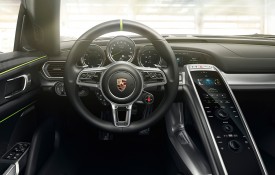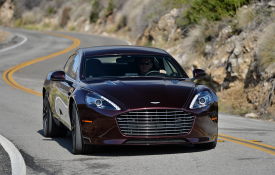 Automotive innovation has embraced a long evolution of the electric plug-in hybrid. Early electric models in the 1800s proved exciting but unsuccessful on the road. Technological advancement unveiled modern models like the Mini E that took stage at the 2008 Los Angeles Auto Show.
Automotive innovation has embraced a long evolution of the electric plug-in hybrid. Early electric models in the 1800s proved exciting but unsuccessful on the road. Technological advancement unveiled modern models like the Mini E that took stage at the 2008 Los Angeles Auto Show.
Today Cadillac continues to raise the bar with its luxury green ELR that debuted in 2014. The 2015 model is a sleek, wedge-shaped coup, said to be a premium version of the Chevrolet Volt. The new plug-in extended-range electric vehicle offers cutting-edge powertrain technology coveted by today’s affluent drivers.
After a wall charge, the front-wheel-drive ELR will travel up to 35 miles on a 16.5-kWh lithium battery pack before tapping into its backup 1.4-litre, four-cylinder gas engine. The vehicle’s quiet engine and tight, agile steering make up for minimum backseat space.
Strategic battery placement offers stability and little torque steer, even at top speeds. The ELR’s sleek dashboard graphics with brand CUE Infotainment System, advanced LED lighting, premium Bose audio system, signature brand grill, adaptive cruise control, Bluetooth connectivity, and refined interior design revoke any notion that green equals deprivation.
Standard safety features include dual front, front side, and full-length side curtain next generation airbags, lane departure warning, forward collision alert, and StabiliTrak stability control. Buyers can even select Luxury and Safety package upgrades including side blind zone and rear cross-traffic alerts.
Four different drive modes include Standard Touch, firmer suspension and steering, sport, and efficient powertrain mountain for hilly terrain. Hold mode allows drivers to switch to the generator engine and conserve battery power. Though slower than some other hybrids, the ELR is meant to be seen as a fashionable, eco-friendly ride and a conscious, considered buy.
Founded over 100 years ago in Detroit, Cadillac is known for performance, design, and groundbreaking technology. The brand is credited for expanding auto paint colors beyond black, launching the world’s first electric self-starting engine, and pioneering the integration of computer technology into vehicles.
Evergreen Alternatives
The inaugural Los Angeles Auto Show in 1907 attracted 3,000 people to Morley’s Skating Rink on Grand Avenue. For the 2014 edition, held over 10 days in November, more than one million people filled 760,000-square-feet of exhibit space at the LA Convention Center. “Green” vehicles dominated the festivities’ North American and Global debuts.

2015 Mercedes-Benz S550 Plug-In Hybrid
As recently as 1992, Mercedes-Benz needed a 6.0-liter V-12 engine to churn out 402 horses. Today, under the hood of their 2015 S550 hybrid, they’re able to hit 436 with a 3.0-liter V-6. Adapting to the rapid increase in fuel-economy requirements, Mercedes is offering up a triumph in technology. As sleek and modern on the outside as ever, the cabin is luxurious and comfortable, providing the driver and passengers with the familiar Mercedes gold standard.
Domestic Arrival Q2 2015
MSRP Starting at $95,00
Horsepower 436
Zero to 60 5.2secs
Fuel Economy 21c/26h
/ mbusa.com
2016 Toyota Mirai
Mirai, Japanese for “future,” is unlike anything else to ever hit the streets and when released will become the first-ever hydrogen fuel-cell car to be offered for sale by a major automaker. Essentially an electric car, the perk of a hydrogen fuel-cell vehicle is that you fill it up with hydrogen gas, which the car converts into electricity. Unlike electric cars, however, a fuel cell vehicle is able to cover 300 miles of range on a single fueling, a five-minute process.
Domestic Arrival Q3 2015
MSRP $58,395
Horsepower 151
Zero to 60 9.0secs
Fuel Economy 56c/59h
/ toyota.com

Monumental moments in the history of the alternative fuel vehicle
1895 Thomas Edison builds a battery-powered front-wheel-drive electric vehicle
1913 Ford Motor Company builds an electric vehicle, the Edison-Ford

1914 For undetermined reasons, despite having invested $1.5 million (roughly $31.5 million today) in the electric-car project, Ford discontinues the venture
1988 GM CEO Roger B. Smith funds electric car research; GM joins California’s AeroVironment manufacturer to design EV1 electric experimental vehicle
1996–2000 Thousands of all-electric models are produced mostly for leasing including the Honda EV Plus, GM EV1, and Ford Ranger EV.
1997 Toyota Prius launches as world’s first mass-produced and marketed hybrid car
2006 Tesla Motors launches Roadster at San Francisco International Auto Show

2008 BMW’s Mini E is unveiled at the Los Angeles Auto Show
2010–2012 Nissan, Chevy, Ford, and Honda release electric vehicles
2013 Porsche 918 Spyder hypercar introduced
2013-14 BMW begins producing i3 and i8 electric and plug-in hybrid models; Cadillac enters luxury green market with ELR













































